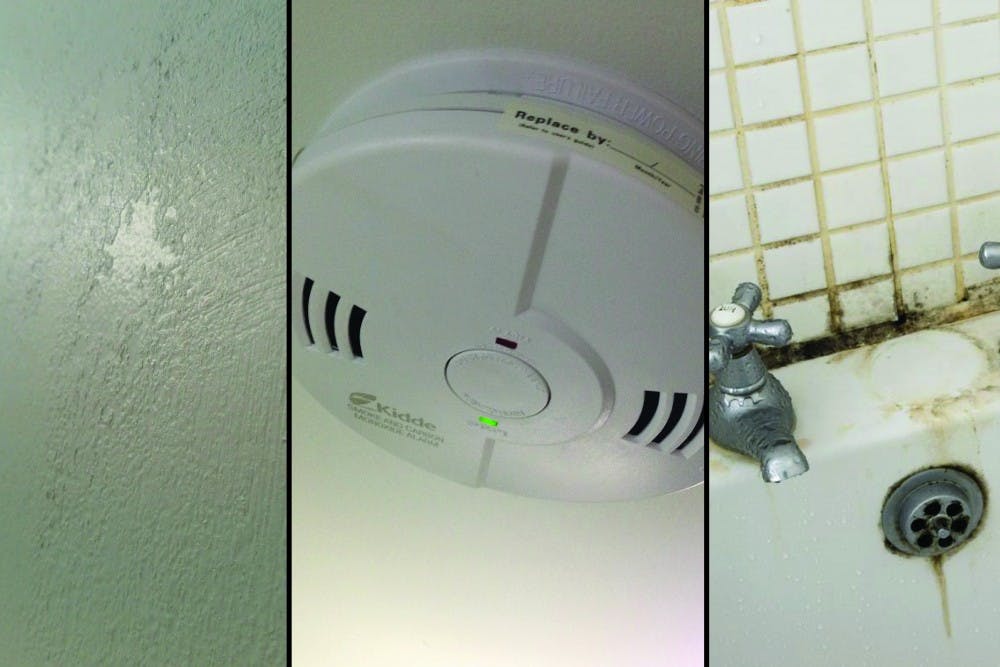Housing risks can have a significant impact on the health of inhabitants, and awareness of common environmental health concerns is the first step in preventing and minimizing health risks.
Common indoor environmental health concerns include mold, carbon monoxide and lead paint, as well as asbestos and other air quality concerns.
Mold
Molds are simple microorganisms that grow in damp places. They can stain or discolor surfaces and usually carry a distinct odor. Most forms of mold are not harmful. Mold grows in wet places, making bathrooms or areas with high humidity and condensation at an especially high risk.
“Mold growth in homes, dormitories, or apartments is typically a sign of water intrusion or an environment with excessive humidity,” R. Thomas Leonard, director of the University Office of Environmental Health and Safety, said in an email to The Cavalier Daily. “Water, and a nutrient source (such as drywall) are essential for mold growth — without both elements, mold will not grow.”
According to the Centers for Disease Control and Prevention, exposure to mold can cause nasal stuffiness, eye irritation, wheezing or skin irritation. Severe reactions to mold include fever and shortness of breath, and individuals with chronic lung illnesses may develop mold in their lungs.
“Some molds excrete toxins called mycotoxins which can induce inflammatory or toxic effects, and some molds can cause infection, but these are fairly uncommon outcomes among healthy populations,” Leonard said.
The Institute of Medicine has definitively linked indoor mold exposure to upper respiratory tract symptoms, coughing and wheezing in healthy individuals, as well as asthma symptoms in individuals with asthma.
The World Health Organization has released additional studies that support a link between early mold exposure and the development of asthma in some children, according to the CDC.
“Selected interventions that improve housing conditions can reduce morbidity from asthma and respiratory allergies,” the CDC said.
Such interventions include avoiding water leaks onto carpet and drywall.
“Once you know that water has found it’s way into your home or apartment through unintentional channels, dry it out as quickly as possible,” Leonard said.
Carbon Monoxide (CO)
Carbon monoxide is an odorless, colorless gas that is lethal even in relatively low concentrations. It can be generated by any incomplete combustion process, including burning of gas, propane and tobacco. CO can be produced by any fuel-burning appliance, including furnaces, water heaters, gas ovens and running vehicles in enclosed spaces.
“Carbon monoxide probably represents the greatest acute risk because of its insidious properties — it cannot be detected by sight and smell, and has the potential to be fatal at high concentrations,” Leonard said.
According to the CDC, carbon monoxide symptoms are “flu-like”.
“The most common symptoms of CO poisoning are headache, dizziness, weakness, upset stomach, vomiting, chest pain and confusion,” a representative from the CDC said in an email.
Carbon monoxide poisoning can cause individuals to faint, and people who are drunk or sleeping can die from poisoning before displaying symptoms.
“When inhaled, carbon monoxide binds to hemoglobin in blood, replacing oxygen which would normally bind to hemoglobin. This mechanism results in a reduction of oxygen distribution to critical organs and tissues,” Leonard said.
Lead
Lead was a common paint ingredient before being banned in 1978, and houses built before that time commonly contain lead-based paint.
“About 24 million older homes in the U.S. contain deteriorated lead-based paint and elevated levels of lead-contaminated house dust,” the CDC representative said. “Even if lead paint is covered by layers of new paint, stripping or sanding the surface could release hazardous lead dust.”
Children are at increased risk for lead poisoning that can damage their central nervous systems and cause cognitive impairment.
“Young kids of course crawl on the ground and tend to put their fingers and various objects in their mouth, and this increases their potential for exposure to any lead dust or debris in their home environment,” Leonard said.
Other than paint, water pipes, toys, toy jewelry, imported candy and traditional home remedies may also contain lead particles. Lead is also commonly used in some hobbies, like making stained glass.
According to Leonard, landlords are required to disclose the existence of lead paint when purchasing or leasing homes built before 1978, and students concerned about lead paint are encouraged to contact their landlords or University Housing and Residence Life. The Office of Environmental Health and Safety can also provide assistance when assessing concerns.
“They have a waiver that says you waive your right to complain if there is lead paint,” fourth-year Batten student Luke Nicholson said.
Nicholson’s building on JPA was built in 1972, six years before lead-paint use was banned by the U.S. government. Nicholson said that he did not take lead-based risks into account when searching for off-Grounds housing, because of limited options.
“You kind of pick whatever you can find, because there’s not enough housing,” Nicholson said. “We weren’t aware of [the lead paint waiver] until we had already poured the deposit and agreed to live here.”
Nicholson emphasized that the lead waiver is located on the last page of the leasing contract.
Other concerns
Other residential environment health concerns include asbestos and radon, and indoor air quality can be degraded by chemicals in cleaning products, pesticides and volatile emissions from carpets and other materials, Leonard said.
“I would say that students should be particularly mindful of fire-related risks in the residential environment,” Leonard said. “Environmental contaminants are often a focus of concern because of the involuntary nature of exposure … yet fire remains among the greatest risks for students nationwide, particularly when living off campus.”
Students living in University-managed properties are unlikely to encounter residential environmental hazards, Leonard said.
“There’s a premium placed on student safety here,” Leonard said. “Our facilities are well maintained and staff are continually mindful of managing risk.”
For any concerns regarding residential environmental health concerns, students can contact HRL or EHS.







